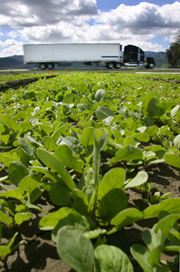Consumer scare shapes local production
The gross value of agricultural commodities produced in San
Benito County crept up $2 million or nearly 1 percent last year, to
$270.9 million.
Consumer scare shapes local production
The gross value of agricultural commodities produced in San Benito County crept up $2 million or nearly 1 percent last year, to $270.9 million.
The figure comes from the annual county Crop Report, a compendium of charts and figures that tracks changes in the volatile agricultural industry.
The biggest mystery in this year’s report was in spinach.
Reports last fall of the intestinal bacteria E. coli in area spinach crops rocked the industry. But in San Benito County, both the value and the acreage devoted to spinach rose. There were 3,898 acres devoted to the crop last year, up 305 acres from a year earlier. Moreover, the crop grossed $16.8 million, up from $14.7 million in 2005.
“If E. coli hadn’t come along, there would have been another 1,000 acres in production and another $3.7 million,” said Paul Matulich, county agricultural commissioner. Matulich and his staff prepare the report each year. “That was the big trend, was people eating spinach salads. Growers were planting spinach in every empty lot.”
Spinach remained at the No. 7 slot in terms of the county’s top value crops.
Nursery stock went from second place into the top spot, with a gross value of $33.4 million. Much of that can be attributed to a single grower, El Modeno Gardens, Matulich said.
The top crop in 2005 was salad lettuce, which plummeted to sixth place, going from $35.7 million to $18.2 million.
Consumer nervousness over contamination affected that crop, too, Matulich said.
“They overproduced because it was such a big deal,” Matulich said. “They got into a glut and the market went down. E. coli affected that too, since there’s spinach in some mixes.
Iceberg lettuce was also down, slipping to 10th place at $8.8 million, $2 million less than a year earlier. The reason is changing buying habits, and consumers who would rather buy a bag of prepared greens than wash their own, Matulich said.
“I think this coming year we’re going to have a lot more broccoli and cauliflower,” he said.
The reason? Blame it on E. coli again, Matulich said.
With consumers still nervous, farmers are switching away from leafy greens to less risky crops.
Change is the ag industry’s greatest constant. Once upon a time, tobacco was a major crop. Warehouses that once were packed with locally grown potatoes still stand in San Juan Bautista. San Juan Valley was once carpeted with flowers, part of the seed industry.
The disappearing crop now is canning tomatoes, Matulich said.
Acreage fell by half last year, to 500 acres. Processing tomatoes are a narrow margin crop. “Growers are still getting $55 per ton – that’s what they were getting 10 or 15 years ago,” Matulich said. “If you get below 40 tons per acre yield, you’re losing money. “Last year, growers managed just over 40 tons per acre.
Market tomato acreage doubled, to 742 acres with a harvest valued at $8.8 million.
The turf industry is ascendant locally, Matulich said. A new producer is preparing to open in the Bolsa District this year.
Orchard acreage continued its long decline. Only cherries held steady at 606 acres with a 2006 harvest worth $6 million.
Apples, apricots and walnuts all experienced small acreage declines.
Thanks to abundant rains that produced a lush crop of grass, cattle producers had a strong year.
Gross receipts for cattle jumped to $21 million, from $16.5 million.
That performance is not expected to be repeated this year, with lean pasture forcing many producers to sell early, before the cattle reached full market weight.










